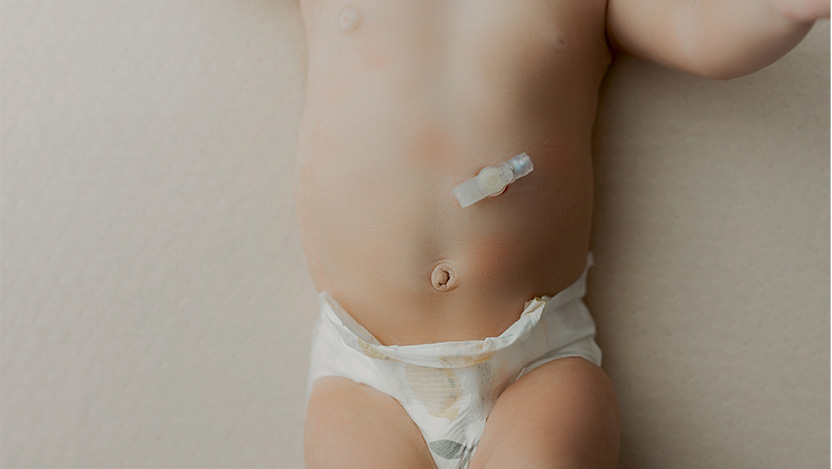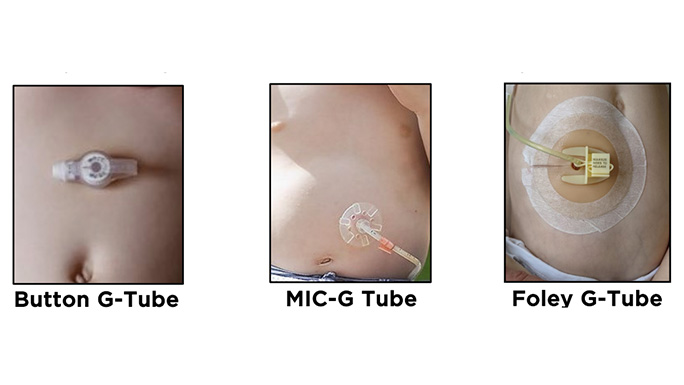Pediatric G-Tube Feeding & Care Guide (Gastrostomy Tube)

Pediatric G-Tube Feeding Support for Patients and Families
At the University of Chicago Medicine Comer Children's Hospital, our specialty nurses work with pediatric patients who have a gastrostomy tube (G-tube). Our team provides post-operative G-tube feeding education and ongoing care to patients.
The pediatric surgery advanced practice nurses (APNs) are available to answer questions about caring for the G-tube and help you with management.
Call 773-702-6169 to speak to our care team
What is a G-tube?
- A gastrostomy is a surgical opening (cut) in your child’s abdomen made for the placement of a gastrostomy tube.
- A gastrostomy tube may be needed if your child cannot swallow or is not able to take enough food or fluids for good nutrition and growth. It can be used for feedings, fluids or medications.
- A gastrostomy tube is also known as a G-tube or feeding tube.
- A G-tube may be temporary or permanent, depending on your child’s needs.
- G-tubes are changed every three months.
- Regular, planned changes do not need to be done in the operating room. They can be done in the clinic by our care team or at home by a family member who has been shown how to change the tube.
About Gastrostomy Surgery
- A pediatric surgeon will place your child’s G-tube in the operating room.
- The G-tube is placed by making a small surgical opening in the abdomen and into the stomach.
- The part of the G-tube that is placed in the stomach has a balloon on the end. The balloon is filled with a small amount of water after it is in placed in the stomach.
- The balloon helps to keep the G-tube in place and helps to prevent leaking.

Types of G-Tubes
There are several different kinds of pediatric G-tubes. This includes:
- Low-profile tubes: This type of tube is one of the most common types and is a skin-level tube that is kept in place with a balloon inside the stomach. It is sometimes referred to as a 'button'.
- Long tubes: These tubes are usually only used if 'button' tubes are not a food fit for the patient.
Your surgeon will choose the best type of g-tube for your child.
When to Contact a Doctor
Pediatric G-tubes are typically easy to maintain, but problems can arise. If anything seems out of the ordinary, please contact your child’s care team immediately. If found early, most issues can be treated quickly. You can contact our APNs at 773-702-6169.
G-Tube Tip Sheets
G-Tube Care Instructions
- General G-Tube Care
- Giving Feedings and Medications with a G-Tube
- Home Care Instructions for All G-tubes
- Possible G-Tube Problems
G-Tube Video Guides
How to Change a Balloon G-Tube
Download step-by-step instructions
[MUSIC PLAYING]
This is a demonstration on how to change a balloon G-tube. Always begin by washing your hands and preparing your supplies.
Next, you will test your new G-tube. Draw up tap water into a syringe, and then you will insert the syringe into the balloon port. Push water into the port to inflate the balloon. Check the balloon for any leaks or tears. Deflate the balloon by pulling water back into the syringe, and disconnect the syringe.
Line up the black line on the extension set and on the G-tube. Push extension set down, and turn to the right to lock in place. Close the clamp on the extension set, and you can now lubricate the end of your new G-tube.
Your new G-tube is ready to go. Place on a clean surface within easy reach. Attach an empty syringe to the balloon port of your child's current G-tube. Withdraw all water by pulling back on the syringe. Lift the G-tube straight out of child, and be prepared with gauze for leakage from the site.
Once the skin is clean, insert the new G-tube. While holding the G-tube in place, attach the syringe, filled with the desired amount of water, into the balloon port. Push water into the port, and then detach the syringe. Open clamp on your extension set, and look for stomach contents to back up into the tubing.
Great job. You have now changed your child's G-tube.
[MUSIC PLAYING]
Balloon G-Tube: How to Check the Water
Download step-by-step instructions
[MUSIC PLAYING]
This is a demonstration on how to check the water in your child's balloon G-tube. Once you have washed your hands and prepared a clean surface, please fill a syringe with the correct amount of water that should be in the balloon.
The nurse practitioner will have given you this number. It is typically between 2.5 and 4 milliliters. Attach a second empty syringe to the balloon port of your child's G-tube.
While holding the G-tube in place, pull back on the syringe to withdraw all of the water from the balloon. Disconnect the syringe and check how much water is in the syringe.
If there is less water than the amount supposed to be in there, connect the prefilled syringe and push the correct amount of water into the balloon.
Great job. You have now checked and change the water of your child's balloon G-tube.
[MUSIC PLAYING]
Contact Our Pediatric Surgery APN Team
